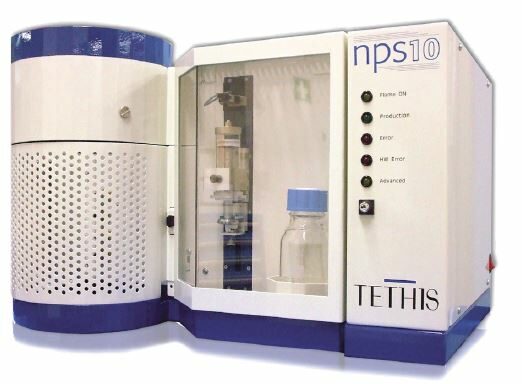Flame Spray Pyrolysis (FSP)
Brand / Model
Tethis NPS10
Features
Inlet gas pressure: Operating range 6 – 9 bar
Max. gas inlet pressure: 10 bar
Supporting flame CH4 flow rate: max 5 L/min
Supporting flame O2 flow rate: max 5 L/min
Dispersion gas type: O2, Air
Dispersion gas flow rate: max10 L/min
Sheath gas type: O2, Air, inert gas
Sheath gas flow rate: max 20 L/min
Precursor flow rate: 0-30 mL/min
Precursor syringe volume: up to 50 ml
Min. cooling water flow rate: 1L/min
Cooling water inlet temp.: 15-20°C
Max. cooling water inlet temp.: 20 °C
Max. cooling water pressure: 10 bar
Filter material: Borosilicate glass microfiber
Filter thickness: 350 μm
Filter porosity: 1 μm
Aim
Flame spray pyrolysis is a widely used method for the synthesis of nanoparticles with different advantages from other methods. In this method, the chemical composition of the nanoparticles has major advantages such as control of particle morphology and control of particle size distribution. In the flame spray pyrolysis method, high-volatility metal halogens are used as starting material, while the resulting vapor phase is transferred to the flame zone by a gas such as air, hydrogen or oxygen.
Click here for application
Duyurular
- Doç.Dr. Hilmiye Deniz Ertuğrul Uygun’un yer aldığı ekibin buluşu ulusal patent tescili almaya hak kazanmıştır.
- “Dalgalı Sulara Dayanıklı Modüler Yüzer İskele Sitemi Tasarımı, Üretimi ve Geliştirilmesi” Konulu TÜBİTAK 1505 Projemiz Kabul Edilmiştir
- DEU ROV TEAM’i TEKNOFEST İnsansız Su Altı Sistemleri İleri Kategori Türkiye 2.’si Oldukları İçin Tebrik Ederiz
- “Gelişmiş Spektral Duyarlılık İçin ZnO/Si Ultraviyole Fotodedektör Geliştirilmesi” Konulu TÜBİTAK 1001 Projemiz Kabul Edilmiştir
- Young Researchers at EMUM!


